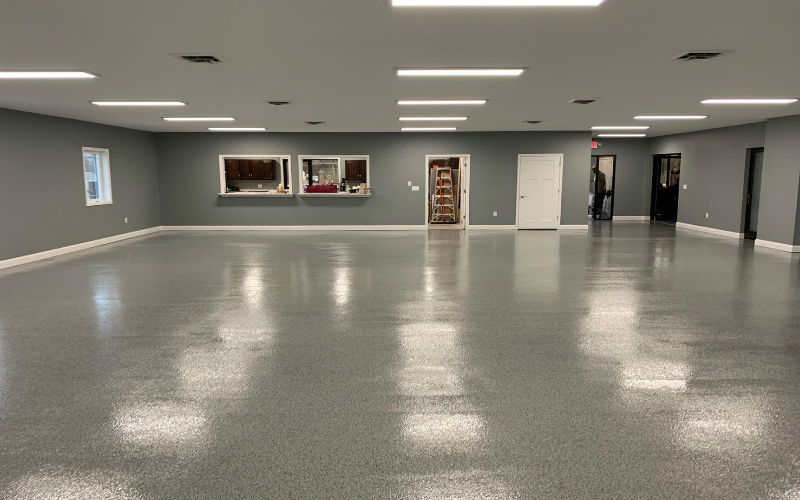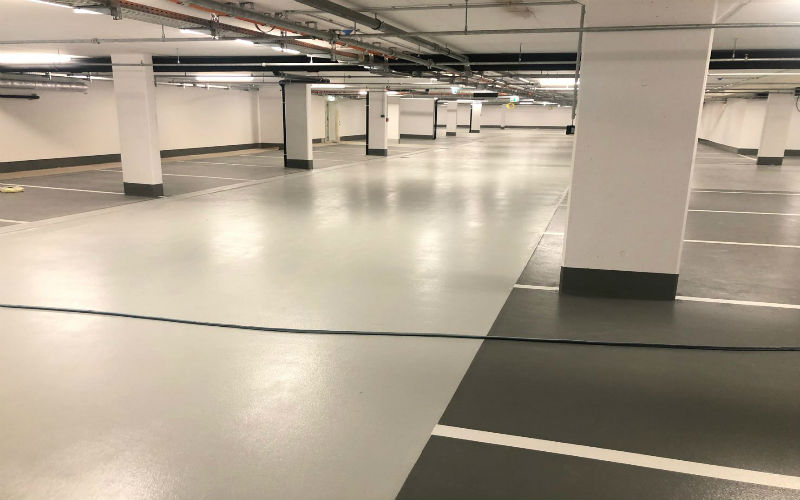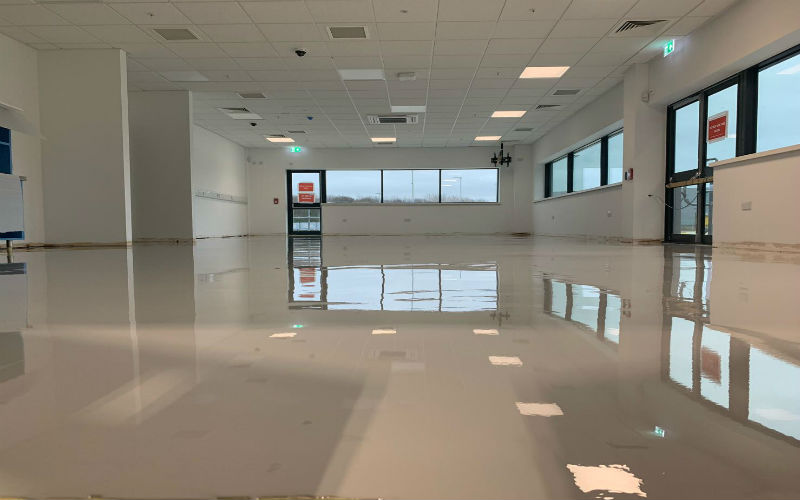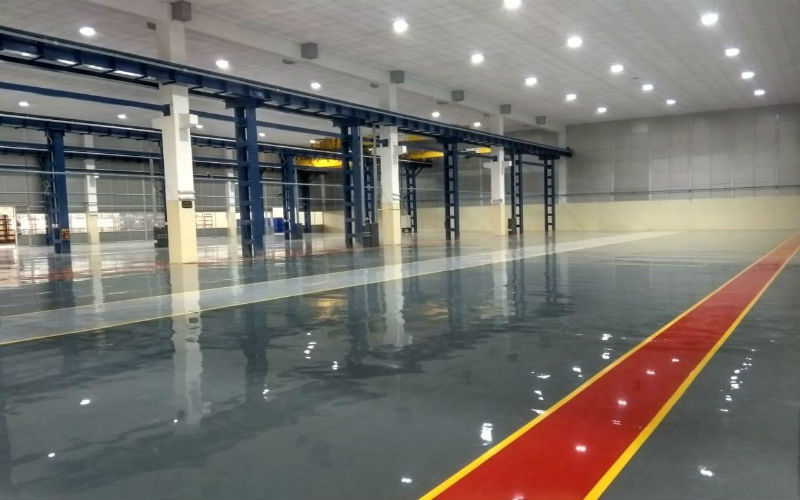Epoxy floors
Epoxy resin flooring for warehouse
Epoxy floor repairs
Epoxy resin flooring for garage
What is an epoxy floor?
How to make epoxy resin floors?
Epoxy resin floors for food production
Epoxy floors are a complex of materials that create durable, wear-resistant, chemical-resistant floors.
The epoxy flooring system is based on: a concrete slab (concrete base) and a two-component epoxy polymer resin (epoxy coating).

Epoxy floor installation
Consider the basic indicators of epoxy floors and in which main industries they are used.
Properties of epoxy floors
-
Epoxy Coating - is a colored, two-component epoxy system, mostly solvent-free.
-
With the addition of quartz sand to the mixture, with an average fraction diameter of up to 0.4 mm, a self-levelling mortar is created that is ideal for covering industrial concrete floors.
-
The epoxy coating has high adhesion to concrete, to cement screed and, in general, to surfaces based on mineral, cement materials.
-
Epoxy coatings have high mechanical strength: hardness combined with relative elasticity and abrasion resistance.
-
Epoxy coating has waterproofing, chemical resistance to acids, alkalis, solvents, fuels and lubricants, sea water and detergents.
- Epoxy coating makes it possible to apply a wide range of color shades and create a variety of surface configurations.
Self-leveling floors for a warehouse
Application of epoxy floors
Installation of an industrial floor at a car wash, followed by the application of an epoxy coating.
-
Self-leveling polymeric epoxy mortar, used as a colored self-leveling protective and decorative coating for floors based on cement materials - concrete, screeds, mosaics, etc.
-
Epoxy resin creates coatings with a thickness of 1 mm to 5 mm, resistant to mechanical stress in accordance with DIN 28052-1.
-
Epoxy floors are designed for vehicle use, with solid tires or for static loads, on average 7 N/mm2 = 700 t/m2.
-
For heavy loads, especially for special loading aids, with polyamide wheels, additional control measurements will be required.
-
In addition to great resistance to chemicals, epoxy floors do not pose any problems with toxicity or migration of harmful substances in food storage areas.
-
The presence of tightness and lack of absorption, allow epoxy floors to comply with the requirements of the Directive of the European Union 93/43 EEC and be used in food production premises.
-
Epoxy floors are easy to clean, disinfect and generally do not harm the health of the staff working in the room, so they are recommended for use in food production.
- Depending on the method of application, the surface of the epoxy floor can be made smooth or non-slip (rough), with a glossy finish.
Polymer coating for a hangar
Physical and mechanical characteristics of epoxy floors
For each manufacturer and for each individual task, epoxy floors have exclusive properties.
The main indicators, requirements and what they pay attention to when choosing epoxy coatings.
|
Mixing ratio of components A: B by weight |
|
Mixture Specific Gravity (A+B): kg/l |
|
Dynamic viscosity of mixture (A+B) (DIN EN ISO 3219) at 23⁰C |
|
Uptime (Α+B) at 20⁰C or at 30⁰C: number of minutes |
|
Minimum curing temperature: + ⁰C |
|
Walking on pavement after 24 hours, at 20°C |
|
Full cure time at 20°C or at 30°C: number of days |
|
Compressive strength (DIN EN ISO 604) |
|
Compressive strength (DIN EN 196-1) |
|
Compression test module (DIN EN ISO 604) |
|
Flexural strength (DIN EN ISO 178) |
|
Flexural strength (DIN EN 196-1) |
|
Bending test module (DIN EN ISO 178) |
|
Shore D hardness (DIN EN ISO) |
|
Peel resistance (adhesion) to concrete substrate (DIN EN ISO1542): N/mm2 - concrete substrate |
|
Abrasion resistance (wear) Taber method (DIN EN ISO 7784 - 2) |
|
Water absorption (DIN EN ISO 62) |

Thin-layer epoxy floor for service stations
Industries of life activities for the application of epoxy floors
Epoxy floors provide the perfect finish for industrial floors such as:
-
epoxy polymer floors for large industrial and small kitchens;
-
epoxy polymer floors for slaughterhouse and meat processing workshop;
-
epoxy resin floors for a seafood processing facility;
-
epoxy resin floors for the canning shop;
-
epoxy resin floors for juice and soft drinks production workshop;
-
epoxy polymeric floors for premises for the production of dairy products;
-
epoxy polymer floors for premises for the production of alcoholic beverages (in wineries and breweries);
-
epoxy resin floors for a bakery;
-
epoxy resin floors for garages;
-
epoxy resin floors for warehouses;
-
epoxy polymer floors for car service;
-
epoxy polymer floors for residential premises;
-
epoxy polymer floors for medical institutions;
- epoxy polymer floors for most industrial premises.

Epoxy floors for food production
- epoxy resin floors for chemical and pharmaceutical industries;

Polymer coating for parking floor
-
epoxy resin floors in department stores;
- epoxy polymer floors in exhibition pavilions.

Self-leveling floors for a warehouse
Epoxy floor installation
Foundation preparation
-
Application of self-leveling epoxy floors should only be carried out on a prepared base.
-
The substrate must be strong, dry, free from dust, rust, grease and dirt, which generally prevents the adhesion of the epoxy coating.
-
Preparatory work includes: sandblasting, water cleaning, grinding, milling, concrete shot blasting.
-
These preparatory works create a relatively rough and porous surface of the base, which, when applying the epoxy composition, increases the consumption of material.
-
When using only a grinder, the base surface becomes less porous, which makes the process more economical in terms of material consumption.
-
Next, dust should be removed from the surface using a powerful industrial vacuum cleaner with high suction power.
Epoxy systems for parking
The concrete base must meet the following fundamental criteria
|
Surface resistance |
≥ 1.5 N/mm2 |
|
Humidity |
≤4% |
|
Concrete strength |
Category at least C 20/25 |
|
cement quality |
Cement content ≥ 350kg/m3 |
|
Concrete, cured |
> 28 days |
|
To avoid peeling |
The epoxy coating must be protected from moisture and primarily from water vapor. |
In such cases, under the base of concrete floors, it is necessary to provide for the creation of waterproofing to protect against water vapor or active exposure to moisture.

Repair of polymeric epoxy floors
Padding
-
Porous cementitious surfaces should be (after substrate preparation and before epoxy coating) treated with an epoxy primer.
-
Generally, epoxy floors have excellent adhesion to both primed and unprimed clean surfaces.
-
Priming , designed to seal surface pores and create a homogeneous base, for the subsequent application of the epoxy composition.
-
Otherwise, air remains inside the pores, which is released from them during the epoxy coating process and appears on the surface in the form of bubbles (degassing).
-
If these bubbles burst, unwanted micro pits form on the surface.
-
At the same time, priming removes dust from the surface, which has a positive effect on the process of adhesion of the material to the base.
Impregnation of the base with epoxy material additionally :
-
improves the strength of concrete;
-
seals hairline cracks and eliminates the problem in case of slight excess of permissible humidity.
-
In these cases, to achieve the desired results, for the greatest possible depth of penetration of the impregnation, special materials of a liquid consistency can be used .
-
Occasionally, if the substrate is highly absorbent, the primer must be repeated until the surface is sealed.
-
After the initial drying of the primer, possible defects in the concrete base (cracks, gouges, chips) should be eliminated with an epoxy repair mixture. This can be a ready-made repair compound or a mixture of epoxy primer and sand.
-
Application of the epoxy coating should be carried out no earlier than 24 hours after the application of the primer.
-
If circumstances do not allow to withstand this time regime, then a fresh primer should be sprinkled with quartz sand (ø 0.1 - 0.7 mm), while spending 1.0 to 1.5 kg of this material per 1 m2.
-
Also, this technology is used for various systems, to increase the adhesion of subsequent layers or to create a rough thin layer coating.
- After the primer has hardened, the remaining sand from the surface is removed with an industrial vacuum cleaner with high suction power.
Dedusting concrete floor
Kneading
-
Components A (resin) and B (hardener) are packed in separate containers (metal cans) and in the required proportion. Therefore, when mixing the entire volume of the package, no additional weighing of the components is required.
-
In the case of mixing components in parts, mandatory weighing on the scales, relative to their proportional ratio.
-
Before mixing the two components, agitation of the color component A is recommended for uniformity.
-
Mixing of two materials, preferably in a third clean vessel, into which the entire contents of the containers are poured, with components A and B.
-
To create a homogeneous mass, when mixing the components, a mixer is used, with low speed (up to 300 rpm).
-
The duration of mixing is about 3-5 minutes.
-
To create smooth surfaces, when adding sand, quartz sand S 114 is recommended, and for non-slip (rough) floors - S 23.
-
This mixture is stirred until a homogeneous mass is formed, ready for use.
Epoxy coating
Epoxy coating requires special but simple tools.
-
Notched trowel with triangular teeth for placing resin.
-
The thickness of the coating depends on the height of the teeth.
-
Instead of a spatula to adjust the thickness of the coating, you can use a spiked roller, an aluminum squeegee;
-
Then, with a needle roller, a new epoxy coating is rolled.
-
This releases the air entrained in the resin, which first creates bubbles on the surface and then bursts to create small cells (degassing)
-
The use of a spiked roller when rolling out a mixture of quartz sand and epoxy helps to create a more uniform surface.
-
When moving on the base when installing epoxy floors, special wet shoes are used.
-
They are worn over shoes and are spiked soles.
-
When moving on a freshly laid floor on such soles, damage to the coating is minimal.
Installation of self-leveling epoxy floors
Recommendations
-
The ambient temperature when using epoxy floors must be at least 10 C – 12 C (so that the substrate temperature is ≥ 80°C) to ensure proper curing.
-
Relative humidity should not exceed 70%.
Otherwise, the reaction of the base surface will be insufficient, this may lead to:
-
to loss of gloss;
-
to the creation of an uncured surface film to be removed by abrasion and the application of water;
-
direct exposure to water on a fresh surface of an epoxy coating, up to 6 hours after laying, can cause phenomena similar to high humidity: discoloration or stickiness of the surface;
-
the damaged surface must be abraded (grinded) and re-applied with an epoxy coating ;
-
moisture and dirt on the surface of the base, pose a threat to high-quality adhesion when applying subsequent layers;
-
if, when applying subsequent layers of epoxy resin, the time interval exceeds the norm or it is necessary to restore the old coating, then the previous surface must be abraded with a grinder to remove surface gloss;
-
then a new coating can be applied without the use of a primer;
-
the surface of any epoxy coating, whether smooth or non-slip (rough), is inherently glossy;
-
to achieve a matt appearance, the gloss is removed in the first two days after installation, by sanding and moisturizing, as in the case of removing the uncured surface film.
Industrial Wear Resistant Epoxy Floors
Epoxy coating consumption
Average consumption: 1.5 kg/mm.
Tool Care
Tools should be cleaned with a solvent-based solvent immediately after use.
Storage and packaging
-
The material should be stored in closed containers, in rooms with a temperature not lower than +10°C in winter and in the shade in summer.
- Shelf life, on average: 24 months.
Note and Precautions
-
Both the resin and the hardener in epoxy resins must not come into contact with the eyes and skin.
-
Inhalation of vapors should also be avoided.
-
Personnel working with this material must be protected with rubber gloves and goggles.
-
If skin comes into contact with resin, hardener or mixture, it should be dried with paper towels and then washed with cold water and soap (recommended to add 2% vinegar).
-
If the material gets into the eye, it should be flushed with plenty of cold water for 10 to 15 minutes, and then an ophthalmologist should be consulted.
- After hardening, the epoxy coating is completely safe for human health.
"High-quality epoxy floors, the key to the efficiency of your business and home comfort"
If you liked this article and found it helpful,














